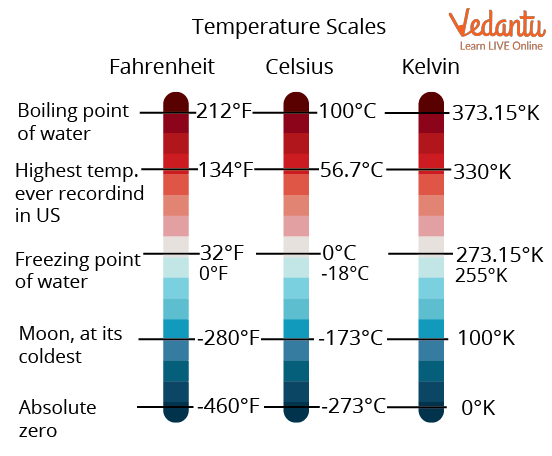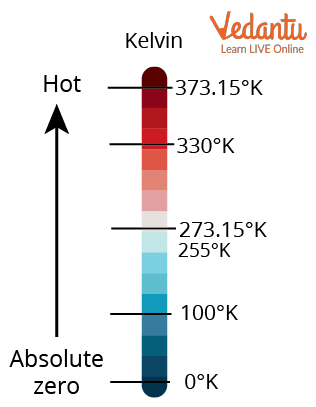




Introduction to Three Scales of Temperature
Hello kids, have you ever fallen ill and your body is too hot when you touch it? Have you imagined why it is hot? It is because of the temperature. Now, let us understand what temperature is and what types of temperatures. Temperature is the heat present in any substance. It can be measured on our body or in a cup of tea also.
Thermometers measure temperature as per size. The three most normal temperature scales are Fahrenheit, Celsius, and Kelvin. Temperature scales are made by distinguishing two temperatures. The freezing and boiling temperatures of water at standard atmospheric pressure are generally used here.

Temperature Scales
Types of Temperature
Fahrenheit Scale
Fahrenheit temperature scale is a scale in light of 32 for the edge of freezing over of water and 212 for the limit of water, the stretch between the two being partitioned into 180 parts. The eighteenth-century German physicist Daniel Gabriel Fahrenheit initially took as the zero of his scale the temperature of an equivalent ice-salt blend and chose the upsides of 30 and 90 for the freezing point of water and normal body temperature, separately; these later were modified to 32 and 96, however, the last scale expected a change in accordance with 98.6 for the last option esteem.
Until the 1970s the Fahrenheit temperature scale was in everyday normal use in English-talking nations; the Celsius, or centigrade, scale was utilized in most different nations and for logical purposes around the world. Since that time, in any case, most English-talking nations have formally embraced the Celsius scale.
The conversion for a temperature that is expressed on the Celsius (C) scale to its Fahrenheit (F) portrayal is:
F = 9/5C + 32.
Celsius Scale
The Celsius temperature scale, likewise called the centigrade temperature scale, is the scale in light of 0 for the edge of the freezing point of water and 100 for the limit of water. Imagined in 1742 by the Swedish cosmologist Anders Celsius, it is at times called the centigrade scale on account of the 100-degree span between the characterized focuses.
The accompanying equation can be utilized to change over a temperature from its portrayal on the Fahrenheit ( F) scale to the Celsius (C) esteem:
C = 5/9(F - 32).
The Celsius scale is overall utilized in any place metric units have become acknowledged, and it is utilized in logical work all over the place.
Kelvin Scale
The Kelvin temperature scale is the base unit of thermodynamic temperature estimation in the International System (SI) of estimation. It is characterized as 1/273.16 of the triple point of unadulterated water. The Kelvin (image K without the degree sign []) is likewise the essential unit of the Kelvin scale, an absolute scale of temperature named for the British physicist William Thomson, Baron Kelvin.
Such a scale has as its zero point outright zero, the theoretical temperature at which the particles of a substance have the least energy.

Scales of Temperature
Summary
Three sorts of thermometers are alcohol, liquid crystal, and infrared radiation (pyrometer). The three primary temperature scales are Celsius, Fahrenheit, and Kelvin.
Temperatures can be changed over starting with one scale and then onto the next utilizing temperature transformation conditions.
The three periods of water (ice, fluid endlessly water fume) can exist together at a single pressure and temperature known as the triple point. The thermometer is used by doctors and we also use it in our home whenever we fall ill.
FAQs on Name the “Three Scales of Temperature”
1. Name different types of thermometers.
Below stated are different types of thermometers:
Digital thermometers
Electronic ear thermometers
Forehead thermometers
Plastic strip thermometers
Pacifier thermometer
Glass and mercury thermometers
2. What is the typical body temperature?
It is generally agreed that the normal body temperature is 98.6°F (37°C). According to some research, the "normal" range for body temperature is between 97°F (36.1°C) and 99°F (37.2°C). The majority of the time, a fever brought on by an infection or disease is indicated by a temperature exceeding 100.4°F (38°C).
3. Why does the body temperature drop?
Lower than 98 degree temperatures could be a sign that anything is wrong. Hypothyroidism and low blood sugar are two medical diseases that can result in low body temperature.





















